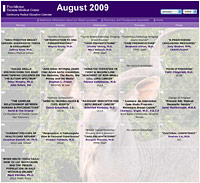Event Report:
Erowid at Providence Tarzana Medical Center
A Continuing Education Lecture on Psychoactive Drugs
Aug 27, 2009
Citation: Erowid F. "Erowid at Providence Tarzana Medical Center". Erowid.org. Aug 27, 2009.
In California, physicians are required to renew their medical license every two years. One of the conditions of license renewal is that the physician must complete 50 hours of continuing education. So each physician in California is basically required to complete 25 hours of classes, lectures, or other approved activities per year.
On August 17, 2009, Earth and I gave a continuing medical education lecture at Providence Tarzana Medical Center in Los Angeles. We were first contacted about the possibility in early 2009, but due to scheduling conflicts, August was the earliest date we were able to arrange. Providence Tarzana Medical Center is a mid-sized hospital in the San Fernando Valley north of Los Angeles. Its continuing medical education program schedules a different lecturer every weekday throughout the year on topics ranging from new cancer treatment options, to health care reform and malpractice issues.
To get a better sense of our audience we also asked how many worked in any mental health field, for example psychiatry, psychology or counseling. Again, nobody in the room raised their hand. The attendees turned out to be more general physicians, surgeons, and oncologists rather than people working in fields directly related to the treatment of psychoactive-related issues or physicians prescribing psychoactive substances for psychological disorders.
Next we discussed some of the complexities inherent in studying, providing information about, and communicating about psychoactive plants and chemicals. We briefly touched on issues such as:
We finished our presentation by briefly describing the new Erowid Expert Network (EEN), designed to bring in professionals who work in fields related to psychoactives to volunteer their expertise in occasionally helping to answer questions about psychoactives. We invited the physicians in the audience to apply to join the EEN or to make use of it as a resource should they need it in the future.
On August 17, 2009, Earth and I gave a continuing medical education lecture at Providence Tarzana Medical Center in Los Angeles. We were first contacted about the possibility in early 2009, but due to scheduling conflicts, August was the earliest date we were able to arrange. Providence Tarzana Medical Center is a mid-sized hospital in the San Fernando Valley north of Los Angeles. Its continuing medical education program schedules a different lecturer every weekday throughout the year on topics ranging from new cancer treatment options, to health care reform and malpractice issues.
Who Attended?
The audience for our lecture was made up mostly of older physicians. Perhaps two-thirds of the 60-70 people in the room appeared older than 60. The rest were doctors in their 30s, 40s or 50s. As part of our introduction we asked how many people in the room were familiar with Erowid; only one person raised their hand, a person who turned out not to be a hospital employee, but rather the son of a staff member who had heard we would be presenting and asked if he could attend. This was, by far, the audience least familiar with Erowid that we have ever spoken in front of.Amusingly, one hospital administrator arrived with a copy of the song "Fantasy" by Earth, Wind & Fire to play before our presentation, poking friendly fun at our names.
Erowid and the Complexity of Psychoactives
As a result, it was appropriate that our lecture began with a description of Erowid Center, its history, motivations, and goals. We briefly described the types of psychoactive herbs, plants, chemicals, and pharmaceuticals that are covered by Erowid.org. And we talked about who makes up Erowid's more than 60,000 visitors a day by age and occupation type, information that we've gathered in numerous visitor surveys over the past 10 years.Next we discussed some of the complexities inherent in studying, providing information about, and communicating about psychoactive plants and chemicals. We briefly touched on issues such as:
- The politically sensitive nature of the topic.
- The difficulty of collecting reliable data about the illegal or disapproved use of recreational psychoactives.
- The wide variation in individual reactions to specific drugs and dosages.
- Varying expectations and motivations behind people's decisions to use or not use psychoactives.
- The spiritual and religious beliefs that either prohibit or encourage use of substances like alcohol, ayahuasca, or peyote.
- The fact that psychoactive drugs can affect the decision-making process of those making decisions about the use of those psychoactives.
- The multi-meaning of the term "drugs" for a) any medication, b) any recreationally used psychoactive whether legal or illegal, or c) any illegal psychoactive.
- The fears that access to information or open discussion of psychoactives will lead to increased use, especially among teens.
Information Useful to Physicians
We then moved on to an in-depth walk-through of the types of information that are available on Erowid.org, especially those that would be of use to physicians. These include:- Basics about recreational drugs, which are useful for determining dosage, duration, and effects of a drug that has been taken by a patient who is being treated.
- Drug slang, which can be used to identify a drug named by a patient.
- Experience reports, which provide insight into the ways various drugs are used recreationally.
- Drug identification photos, which can both help a doctor identify what drug a patient has taken, but can also be useful for presentations and lectures.
- Information about novel psychoactives that have little history of use in humans.
We finished our presentation by briefly describing the new Erowid Expert Network (EEN), designed to bring in professionals who work in fields related to psychoactives to volunteer their expertise in occasionally helping to answer questions about psychoactives. We invited the physicians in the audience to apply to join the EEN or to make use of it as a resource should they need it in the future.




